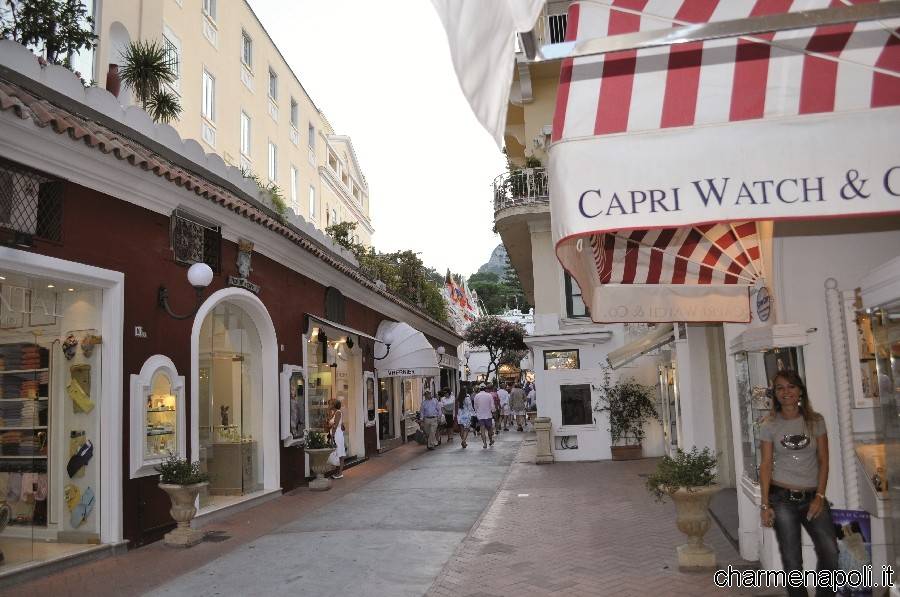Credit crunch? Globalisation? Counterfeits? No worries! Visitors and tourists will be tempted and amazed by what is on offer on Capri, an island whose raison d’être lies in exclusive, élite tourism. Capri’s aficionados say that shopping on the island is a unique experience and compare the quest for the latest designer fashions, precious jewellery, made-to-measure sandals or the famous Capri Pants to waiting for the birth of your child. Local artisans showcase the articles for which the island is famous, and artists open their doors so that visitors can admire their paintings, sculptures and ceramics. Tourists in search of original souvenirs rummage around in cobblers’ and lace-makers’ workshops, visit the perfumeries which capture the essence of Capri’s flowers, or step into the stores selling limoncello liqueur. But they simply must try some of the local food and wine in a delicatessen or restaurant or sip an aperitif in the Piazzetta, the world’s most exclusive square. [charme-gallery]Not far away is Via Camerelle, home to the boutiques and ateliers of the most prestigious Italian and international designers. Another famous and colourful street is Via Le Botteghe, with its important boutiques and jewellery stores, their windows sparkling with necklaces, bracelets and pearl and coral earrings. Via Vittorio Emanuele with its luxury stores is the heart of the town but the showrooms of Anacapri should not be missed: exclusive clothing, souvenirs, perfumes, inlaid wood items and artworks can be purchased in Via Axel Munthe. Sorrento, Capri’s next-door neighbour, is the world capital of inlaid wood, marquetry and intarsia, and its numerous, original, hand-crafted products are on display in shops around the central square and all over the town centre, where small workshops can be visited to see the artisans at work. Their painstaking work produces beautiful objects which can be seen in various stages of manufacture as they are placed in presses along the streets so that the glue can dry in the warm sun. A relaxing walk down the lanes of the centre is the best way to explore the town’s stores, stopping to sip a glass of limoncello or take in the view from the belvedere, but the shopping heart of Sorrento is in Piazza Tasso and all along Corso Italia to the historic centre. The luxury shopping theme links Sorrento to the ‘pearls’ on the Amalfi Coast. Positano launched its own fashion look and is now renowned worldwide for its bright colours, lightweight fabrics and the delicate lace and embroidery that make every garment unique and ideal for any time of day. [charme-gallery]Positano fashions are enhanced each year by new fabrics (gauze cotton, satin, taffeta) and new styles created by the flair of Positano’s designers. Tourists flock to Via Colombo and Via Pasitea to admire, try on and buy beautifully tailored garments. In the 1950s young girls were taught to sew the first Positano fashions, such as the bikini (1959) followed by large white handkerchiefs which eventually became refined and colourful sarongs. Not only does this industry attract tourism but it also creates employment for hundreds of local inhabitants in weaving workshops. Amalfi is likewise renowned for its craftsmanship, above all the manufacture of sandals, clogs and comfortable, canvas sneakers. From Piazza Flavio Gioia to Valle dei Mulini, countless shops sell souvenirs, limoncello, other typical liqueurs and the many other forms of local craftsmanship like Vietri ceramics and coral jewellery, making a walk through the town even more of a pleasure. Local food specialities are also on sale: cakes with limoncello, oranges or almonds, fruit tarts, biscuits, jam, savoury pies, traditionally made ice cream and vegetable conserves. Particularly popular with tourists is the superb Amalfi paper, the town’s main industry since 1200 AD and one of the reasons for Campania’s worldwide fame, because anything written on Amalfi’s soft, elegant paper becomes something special. The Paper Museum shows the ancient mills in operation as well as traditional manufacturing processes for hand-made paper, which are still used today.

 Italiano
Italiano














